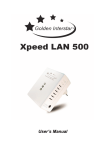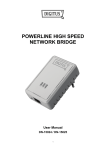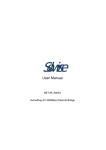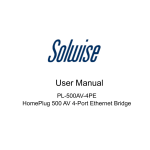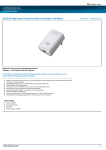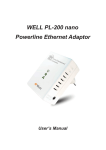Download Intellinet AV 500
Transcript
POWERLINE AV ETHERNET ADAPTER USER MANUAL MODELS 503273, 503280, 506557, 506564, 506571 Model 506557: AV500 / 1-Port Model 506571: AV200 / 3-Port INT-503273/503280/506557/506564/506571-UM-0408-05 INTRODUCTION Thank you for purchasing the INTELLINET NETWORK SOLUTIONS™ Powerline AV200 Ethernet Switch, Model 506571 (3-port) or Powerline AV200 Ethernet Adapter, Model 503273; or Powerline AV500 Ethernet Adapter, Model 506557. The Starter Kits — Models 503280 (AV200) and 506564 (AV500) — feature a pair of units, the minimum number required to operate the devices. These Powerline AV200 and AV500 Ethernet devices allow you to create a highspeed network for your home or office by simply plugging them into any electrical outlet. You immediately create a network using the existing AC power lines that enables high-speed, crystal-clear streaming of 1080p high-definition (HD) video — great for such popular items as network-enabled gaming consoles and digital media devices. Detailed instructions in this user manual make installation reasonably quick and simple, so you’ll soon be enjoying the benefits of all these additional features: • The latest generation of Powerline technology with higher throughput and enhanced security • Up to 500 Mbps network data rates (up to 200 Mbps for Models 503273 and 506571) and data security through 128-bit encryption • Enables high-quality video streaming, VoIP and gaming over a home network • Plug and Play (no drivers required) • Software-free security configuration with a simple push of a button • HomePlug AV compliant • Compatible with Intellinet Powerline AV/HD200 Ethernet Adapters • Can co-exist with HomePlug 1.0* • Three-Year Warranty * The Powerline AV200 and AV500 Ethernet Adapters/Switches are not compatible with the Powerline Turbo Ethernet Bridge, but the products can co-exist on the same power line without interfering with one another. 2 INITIAL SETUP Each Powerline AV Ethernet Adapter/Switch (or “Bridge”) allows you to connect one device (or three devices, with Model 506571) that has an Ethernet port to a power line network. In operation, the bridge is completely transparent: It simply passes data from the Ethernet port along the power line network. In turn, any Ethernetenabled device may be connected to that bridge’s Ethernet port, as in the examples below. Powerline AV Ethernet device NOTE: Each Powerline Adapter/Switch/Bridge needs to pair with at least one other such device in order to create a working system. 3 Connections 1. Connect one end of the included Ethernet cable to the Ethernet port on the bottom of the device. 2.Plug the adapter/switch into an AC power outlet. CAUTION: Do not plug the device into a power strip or wall outlet that uses surge protection, Ethernet as this may prevent the device from working Reset Security button port button properly. 3.Connect the other end of the Ethernet cable to an Ethernet port on your modem or router. 4.Repeat Steps 1-3 for a computer, a network-enabled gaming console, a digital media device, etc. Use additional cables (not included) for Model 506571. 5.Confirm that the LEDs on the front panel are lit, as explained below. Indicators and Buttons Reset indicator Power LED: Lights to indicate the unit is receiving electrical power. PL LED: The Powerline (PL) LED indicates the overall network speed. • Red = weak signal; slow network speed below 50 Mbps • Orange = normal signal; standard network speed of 50-100 Mbps • Green = excellent signal; optimal network speed above 100 Mbps • Off = No activity/connection ETH LED: Lights green to indicate the corresponding 10/100Mbps port (3 ports and LEDs on Model 506571) is linked; blinks to indicate the port is transmitting or receiving; remains off when inactive. Reset: To clear all data and restore settings to their factory default values — a Troubleshooting suggestion should you have difficulty communicating between devices — use a pin to press and hold this recessed button for 2 seconds while the device is plugged in. (Do this with each unit you are trying to connect.) The Reset indicator will flash as the device resets and attempts to link using default settings. Security: Press as directed in the Network Setup instructions below. 4 INDEPENDENT NETWORK SETUP All Powerline AV Ethernet Adapters/Switches are set with a default security key so they automatically link to all other such devices sharing the same electrical lines. If there are other such devices in the building (in an office or apartment building, perhaps), you may want to create your own individual (independent) network group so other Powerline AV Ethernet devices can’t connect to your network. Creating a New Independent Network (Network AB) As shown below, two unassociated Adapters/Switches (Bridge A and Bridge B) form a new network: Network AB. 1. Press and hold the Security button on Bridge A for 10 seconds. Release it when the Power LED flashes. The password to Bridge A has just been erased, and the device must now be linked to your network to adopt the new network security key. 2. Press and hold the security button on Bridge B for 10 seconds and release it when the Power LED flashes. The password to Bridge B has just been erased, and this second device also must now be linked to your network to adopt the new network security key. NOTE: At this point, Bridge A and Bridge B are not networked. 3. Press and hold the Security button on Bridge A for 2 seconds. The Power LED starts to flash. 4. Within 2 minutes of the Power LED on Bridge A beginning to flash, press and hold the Security button on Bridge B for 2 seconds. Bridge A and Bridge B are now networked together. 5 Adding Bridge C to Existing Network AB (Network ABC) As shown below, one unassociated Switch (Bridge C) is added to expand an existing network: Network AB. 1. Press and hold the Security button on Bridge C for 10 seconds. Release it when the Power light flashes. The password to Bridge C has just been erased and the device must now be linked to your network to adopt the new network security key. 2. Press and hold the security button on Bridge A for 2 seconds. The Power LED on Bridge A starts to flash. 3. Within 2 minutes of the Power LED on Bridge A beginning to flash, press and hold the Security button on Bridge C for 2 seconds, then release it. Bridge A, Bridge B and Bridge C are now networked to each other. 6 Removing Bridge B from Bridge A & C Network and Joining with Bridge D & E (Network BDE) 1. Press and hold the Security button on Bridge B for 10 seconds. Release it when the Power LED flashes. The password to Bridge B has just been erased and removes itself from Bridge A & C. 2. Press and hold the Security button on Bridge D for 2 seconds. 3. Within 2 minutes of the Power LED on Bridge D beginning to flash, press and hold the Security button on Bridge B for 2 seconds, then release it. Bridge B and Bridge D are now connected to each other, which in turn becomes part of Network BDE. 7 TROUBLESHOOTING If any of the Powerline AV Ethernet Adapters/Switches in your network have difficulty communicating with one another, consider the following suggestions. • Try power-cycling the unit by unplugging it from the wall for 10 seconds and plugging it in again. • Use a pin and hold the Reset button in for 2 seconds on each unit you’re trying to connect. The Reset light will flash as the units reset and attempt to link using default factory settings. • Try plugging the device into an adjacent plug. • Powerline AV Ethernet Adapters/Switches work best when plugged directly into the wall outlet. Connecting them to a power strip or surge protector may degrade network performance or completely stop network signals. • Don’t connect Powerline AV Ethernet Adapters/Switches to GFI-protected outlets, as some outlets will filter out the signal. • Don’t use Powerline AV Ethernet Adapters/Switches in areas with excessive heat. • Certain fluorescent or incandescent lights are noise sources on the electrical circuit and can degrade performance. • If your building has more than one circuit breaker box, your Powerline AV Ethernet Adapters/Switches may not be able to connect between the different boxes. In this case, connect one Powerline AV Ethernet device to a power outlet located on each of the circuit boxes. Connect Ethernet cable between each of the Powerline AV Ethernet devices to link the different circuits together. This will allow devices from different circuit breaker boxes to connect. 8 SPECIFICATIONS Standards • IEEE 1901 / HomePlug AV • IEEE 802.3 10Base-T • IEEE 802.3u 100Base-TX • IEEE 802.3ab (Twisted Pair Gigabit Ethernet), Model 506557 Certifications • HomePlug AV Powerline certification • FCC Part 15, Part B, Class B • CE • RoHS General (Models 503273 & 506571) • 10/100 RJ45 port • AC power line port • Chipset: Atheros AR6400 • Link speed: up to 200 Mbps • 500 Mbps PHY rate max. • 128-bit AES Link Encryption with key management for secure power line communications • OFDM modulation • 1024/256/64/16/8 - QAM, QPSK, BPSK, ROBO carrier modulation • Frequency band: 2 – 28 MHz General (Model 506557) • 10/100/1000 RJ45 port • AC power line port • Chipset: Atheros AR7400 • Link speed: up to 500 Mbps • 500 Mbps PHY rate max. • 128-bit AES Link Encryption with key management for secure power line communications • OFDM modulation • 1024/256/64/16/8 - QAM, QPSK, BPSK, ROBO carrier modulation • Frequency band: 2 – 50 MHz • Ethernet Link/Activity Power • Internal: 100 – 240 V AC, 50 – 60 Hz • Power consumption: 4.3 Watts (max.) Environmental • Dimensions: 103 (L) x 74 (W) x 34 (H) mm (4.1 x 2.9 x 1.3 in.) • Weight: 130 g (0.3 lbs.) • Operating temperature: 0 – 40°C (32 – 104°F) • Operating relative humidity: 10 – 90%, non-condensing • Storage temperature: -10 – 70°C (14 – 158°F) • Storage relative humidity: 10– 90%, non-condensing Minimum System Requirements • Existing Powerline AV200/500 Ethernet Adapter/Switch • TCP/IP protocol • CD-ROM drive • Configuration utility requires Windows XP, Vista, Windows 7 LEDs • Power • Power line Link/Activity 9 WASTE ELECTRICAL & ELECTRONIC EQUIPMENT Disposal of Electric and Electronic Equipment (applicable in the European Union and other European countries with separate collection systems) This symbol on the product or its packaging indicates that this product shall not be treated as household waste. Instead, it should be taken to an applicable collection point for the recycling of electrical and electronic equipment. By ensuring this product is disposed of correctly, you will help prevent potential negative consequences to the environment and human health, which could otherwise be caused by inappropriate waste handling of this product. If your equipment contains easily removable batteries or accumulators, dispose of these separately according to your local requirements. The recycling of materials will help to conserve natural resources. For more detailed information about recycling of this product, contact your local city office, your household waste disposal service or the shop where you purchased this product. In countries outside of the EU: If you wish to discard this product, contact your local authorities and ask for the correct manner of disposal. COMPLIANCE STATEMENTS FCC Class B This equipment has been tested and found to comply with the limits for a Class B digital device, pursuant to Part 15 of Federal Communications Commission (FCC) Rules. These limits are designed to provide reasonable protection against harmful interference in a residential installation. This equipment generates, uses and can radiate radio frequency energy and, if not installed and used in accordance with the instructions, may cause harmful interference to radio communications. However, there is no guarantee that interference will not occur in a particular installation. If this equipment does cause harmful interference to radio or television reception, which can be determined by turning the equipment off and on, the user is encouraged to try to correct the interference by one or more of the following measures: • Reorient or relocate the receiving antenna. • Increase the separation between the equipment and the receiver. • Connect the equipment to an outlet on a circuit different from the receiver. • Consult the dealer or an experienced radio/TV technician for help. FCC Radiation Exposure Statement This equipment complies with FCC radiation exposure set forth for an uncontrolled environment. To avoid the possibility of exceeding FCC radio frequency exposure limits, human proximity to the antenna shall not be less than 20 cm (8 inches) during normal operation. The antenna(s) used for this transmitter must not be co10 SECTION NAME located or operating in conjunction with any other antenna or transmitter. The equipment version marketed in the U.S. is restricted to usage of channels 1-11. R&TTE This device complies with the requirements of R&TTE Directive 1999/5/EC. The ETSI version of this device is intended for home and office use in Austria, Belgium, Denmark, Finland, France, Germany, Greece, Ireland, Italy, Luxembourg, the Netherlands, Portugal, Spain, Sweden and the United Kingdom, and is also authorized for use in EFTA member states Iceland, Liechtenstein, Norway and Switzerland. 11 INTELLINET NETWORK SOLUTIONS™ offers a complete line of active and passive networking products. Ask your local computer dealer for more information or visit www.intellinet-network.com. Copyright © INTELLINET NETWORK SOLUTIONS All products mentioned are trademarks or registered trademarks of their respective owners.












